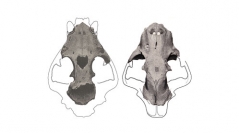

 Comptes Rendus Palevol
16 (8) - Pages 850-864
Comptes Rendus Palevol
16 (8) - Pages 850-864By the late 19th and early 20th centuries, authors described several specimens belonging to a very large felid, the size of a lion, from some Late Pleistocene localities at southern Chile and Argentina. These remains were considered as belonging to large and now extinct subspecies of jaguar. In the present contribution based on qualitative and quantitative postcranial and cranial characters, we conclude that that the “Patagonian Panthera” should be considered as representing remains of the American Cave Lion Panthera atrox. Evidence at hand indicates that Panthera atrox was a very large lion-like felid, with reddish skin, that inhabited dry open habitats. Furthermore, in contrast to living jaguars, transported and accumulated its preys in rocky dens. The presence of at least two pantherine lineages (i.e. P. onca and P. atrox) in the Pleistocene of South America indicates that the lineage has a long and complex history in the New World, and that the history of the clade in this landmass is still far from being well understood.
Patagonia, Cave Lion, Panthera atrox, Panthera onca mesembrina, Late Pleistocene